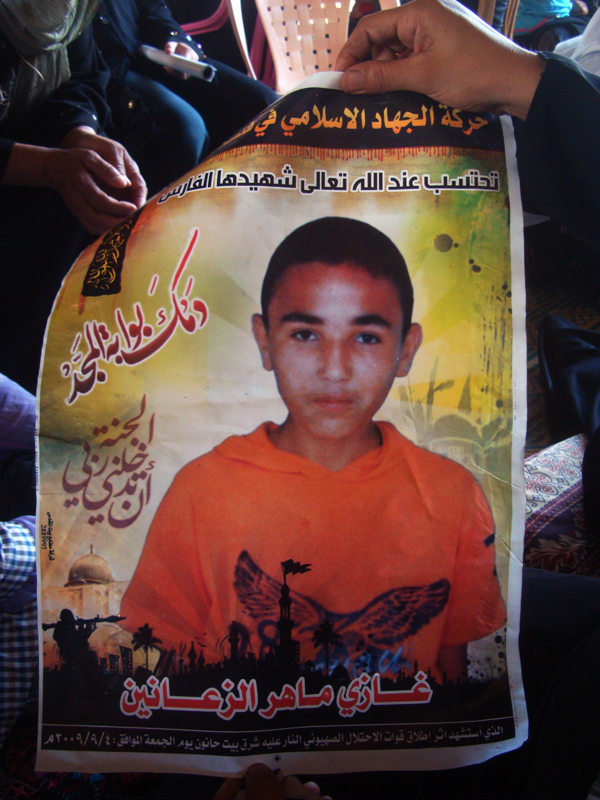22 September 2011 | International Solidarity Movement, Gaza
For three years the Beit Hanoun Local Initiative and the International Solidarity Movement have marched into the buffer zone north of Beit Hanoun. Tuesday, September 20th was no different. We gathered near the agricultural college, and at 11 AM we marched north into the buffer zone. There were about thirty of us. The sun was hot, but spirits were high. Over the megaphone we played Bella Ciao and chanted for a free Palestine.
As we crested the hill nearest the buffer zone we were greeted with a new sight. The tower in the wall closest to where we protest had been covered with netting used to hide snipers. We could see the dust of tanks rising from behind the wall. This did not deter us. We marched into the buffer zone. We were propelled both by the horrors of the past and hope for the future. Twenty nine years ago the world was just learning of the massacre of Sabra and Shatilla. Thousands of Palestinian refugees were slaughtered in these two camps by Lebanese Phalangists with the support of their Israeli allies. This massacre will not be forgotten. Today though, was also a day of hope. The Palestinian Authority was going to the UN to seek recognition of the Palestinian State. Hopefully this new initiative will help to bring 44 years of occupation and 63 years of Nakba to an end.
We advanced to about 50 meters from the wall. We stood along the ditch which scars the buffer zone. Sabur Zaaneen from the Beit Hanoun Local Initiative spoke of his hope for the future, that the Palestinian people would finally know the justice that has so long been denied to them. He vowed that “we will continue the peaceful popular struggle until the occupation ends.”
As we chanted against the occupation a window on the tower began to open so that the soldiers could shoot at us. We marched back through the buffer zone and into Beit Hanoun. Hopefully, somewhere, someone, heard us, heard our calls for justice, freedom and peace.
Updated on September 22, 2011
For three years the Beit Hanoun Local Initiative and the International Solidarity Movement have marched into the buffer zone north of Beit Hanoun. Tuesday, September 20th was no different. We gathered near the agricultural college, and at 11 AM we marched north into the buffer zone. There were about thirty of us. The sun was hot, but spirits were high. Over the megaphone we played Bella Ciao and chanted for a free Palestine.
As we crested the hill nearest the buffer zone we were greeted with a new sight. The tower in the wall closest to where we protest had been covered with netting used to hide snipers. We could see the dust of tanks rising from behind the wall. This did not deter us. We marched into the buffer zone. We were propelled both by the horrors of the past and hope for the future. Twenty nine years ago the world was just learning of the massacre of Sabra and Shatilla. Thousands of Palestinian refugees were slaughtered in these two camps by Lebanese Phalangists with the support of their Israeli allies. This massacre will not be forgotten. Today though, was also a day of hope. The Palestinian Authority was going to the UN to seek recognition of the Palestinian State. Hopefully this new initiative will help to bring 44 years of occupation and 63 years of Nakba to an end.
We advanced to about 50 meters from the wall. We stood along the ditch which scars the buffer zone. Sabur Zaaneen from the Beit Hanoun Local Initiative spoke of his hope for the future, that the Palestinian people would finally know the justice that has so long been denied to them. He vowed that “we will continue the peaceful popular struggle until the occupation ends.”
As we chanted against the occupation a window on the tower began to open so that the soldiers could shoot at us. We marched back through the buffer zone and into Beit Hanoun. Hopefully, somewhere, someone, heard us, heard our calls for justice, freedom and peace.














